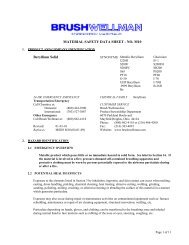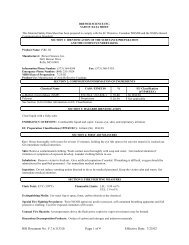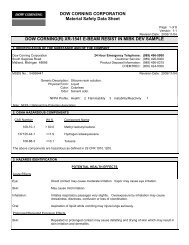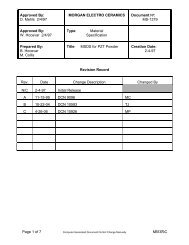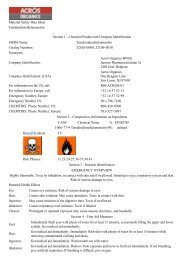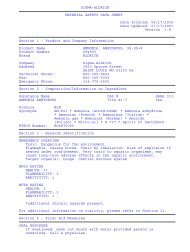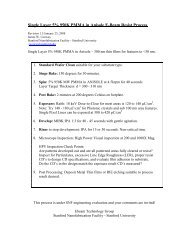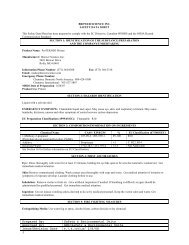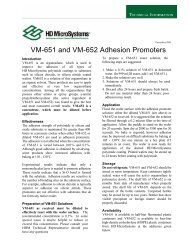EE 410 / Saraswat Handout #3 - Stanford Nanofabrication Facility
EE 410 / Saraswat Handout #3 - Stanford Nanofabrication Facility
EE 410 / Saraswat Handout #3 - Stanford Nanofabrication Facility
You also want an ePaper? Increase the reach of your titles
YUMPU automatically turns print PDFs into web optimized ePapers that Google loves.
<strong>EE</strong><strong>410</strong> / <strong>Saraswat</strong> <strong>Handout</strong> <strong>#3</strong><br />
4A. Week #1: Preparation<br />
SECTION 4 - Process Details<br />
1. Wafer Start (STEP 00.00):<br />
C Prime Stock: CZ, oriented, N-type (phosphorus-doped), 5 - 10 Ω-cm. Dimensions: 100<br />
mm (4-inch) diameter, 525 ± 15 µm thickness<br />
Wafer Selection & Sheet Resistivity Measurement:<br />
Do you trust the label on the box? You shouldn’t. Check at least one wafer from each box. Also,<br />
take a look to be sure the rest are in good shape and not “test” wafers.<br />
• Measure and record the sheet resistivity of the wafers using the Tencor Instrument<br />
Sonogage. It is sufficient to do this only on test wafers.<br />
STANDARD PIRANHA CLEAN:<br />
It might seem strange, but new wafers are not very clean. In addition we have just covered them<br />
with silicon dust. So they get a full scrub down using a Standard Piranha Clean.<br />
2. PM #0: Zero Level Marks (STEPS 0.100-0.190):<br />
The ASML stepper files are setup so that all the mask layers are aligned relative to the zero level<br />
marks defined before "real device processing" begins. When setting up the run files, the user can<br />
choose one or more standard "PM" marks to be placed anywhere on the wafer at the zero layer.<br />
Ideally, these would be placed at wafer edges, although they may also be placed in scribe lines as<br />
needed. After lithography, the PM marks will be etched into the silicon substrate to a targeted<br />
depth of 1200 A, which should provide sufficient contrast for alignment. Similar PM marks are<br />
written into the reticle frame. During alignment, a laser is directed through the reticle PM mark<br />
to the wafer level PM mark. These PM marks are cleverly designed to exhibit characteristic<br />
interference patterns when wafer-level and reticle-level marks are superimposed, i.e., perfectly<br />
aligned. Thus, it is absolutely important to know exactly where your device image is relative to<br />
the reticle center. Nearly all the file definition can be done on the ASML system emulator,<br />
located outside the lab.<br />
The litho process steps are:<br />
• Singe & Prime in the yes<br />
• Spin coat using svgcoat/2 programs 9 (no prime), 7 (1.0 µm of 3612 resist w/2 mm EBR),<br />
and 1 (prebake 90 C for 60").<br />
• Expose on the asml<br />
Job name: <strong>EE</strong><strong>410</strong>R_1<br />
Layer ID: 0<br />
Layer Number: 0<br />
Image ID: PM<br />
Reticle ID 45023981A009<br />
• Post-exposure bake on svgdev/2 using programs 9 (no develop) and 1 (postexpose<br />
bake@110º C for 60").<br />
• Resist develop on svgdev using programs 3 (develop) and 1 (postbake@110º C for 60")<br />
• Inspect and rework as necessary.<br />
Revised Jan. 11, 2008 Page 14/47



